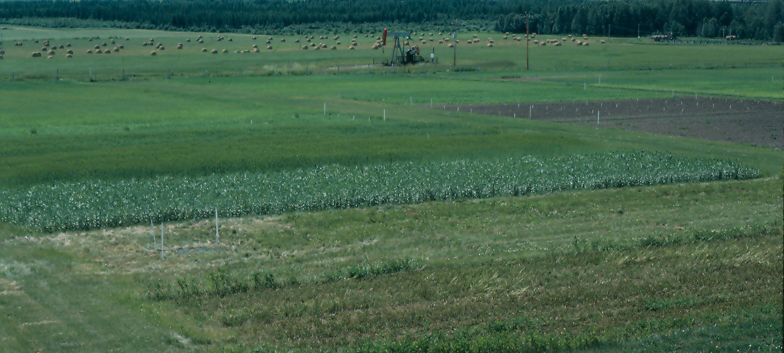
The Hendrigan Plots were named for Lou Hendrigan, a local farmer who believed the best agricultural system for the Gray soils was a continuous forage system, grown to feed cattle on a mixed farm. He thought the best forage for the area was a mixture of fescue grass, which is suited to the soil and climate, and a legume such as White Dutch Clover. The purpose of the clover is to fix nitrogen from the atmosphere and supply it to the soil, and the grass adds organic matter, especially because of its large root systems.
Established in 1980
They consist of three cropping systems:
- continuous Barley, with straw, returned to the plots after harvest,
- continuous Forage (fescue grass and white clover, in keeping with Mr. Hendrigan's theories), and
- an eight-year 'Agroecological´ rotation of Barley-Fababeans-Barley-Fababeans-Barley-Forage-Forage-Forage, where the forage crop is a mixture of bromegrass and red clover.
The question of which was the better grass - fescue or brome - was a friendly debate between Mr. Hendrigan and the soil scientists at the University of Alberta.

Nitrogen, phosphorus, potassium and sulphur fertilizers are used in the cropping systems, but no nitrogen fertilizer is added to the Agroecological system because the clover and faba beans supply nitrogen. Some manure is added to the first year of barley in this system.
The ecology of the Agroecological rotation
The Agroecological rotation incorporates the principles of ecology into an agricultural cropping system in several ways. There is minimal disturbance to the soil, so organic matter remains intact. Inputs of fertilizers and pesticides are infrequent. Nitrogen fertilizer is unnecessary because legumes replenish soil nitrogen during the three forage years of the rotation. Weeds are controlled by including crops with different rooting habits and life cycles in the rotation. This keeps soil microbial communities diverse and healthy, builds up soil organic matter, and improves soil structure and quality in the Gray soils.
Using different crops also makes efficient use of water, solar radiation, and other resources. For example, the alfalfa grown during forage years starts earlier in the season than barley and takes advantage of the resources available then. This increased 'resource use efficiency' improves productivity and yield, and there are few losses of nutrients and organic matter since the soil is seldom disturbed, especially in forage years. As a result, minimum input systems such as this can still produce high outputs. The Agroecological cropping system may help determine if minimum-input systems are sustainable.
Classical and Hendrigan plots compared
The Classical and Hendrigan plots showcase a broad spectrum of cropping systems. On one end of the spectrum, the Wheat-Fallow system of the Classical Plots is the most exploitive and conventional of agricultural systems, especially in north-central Alberta. It is unnecessary to conserve moisture by summer following in this region, but in the Classical Plots, this system is used to control weeds.
On the other end of the spectrum, the cropping system most in tune with ecological principles is the continuous Forage (grass and legume) system of the Hendrigan Plots. Because forages maintain themselves, it is a closed system in which the soil remains mostly undisturbed.
Next along the spectrum from 'ecological' to conventional agriculture is the eight-year Agroecological system (Hendrigan), then the five-year system of cereals and forages (Classical), then the continuous Barley system (Hendrigan), and finally the Wheat-Fallow system (Classical). The wide range of cropping systems allows researchers to observe changes in the soil that result from different agricultural practices.
